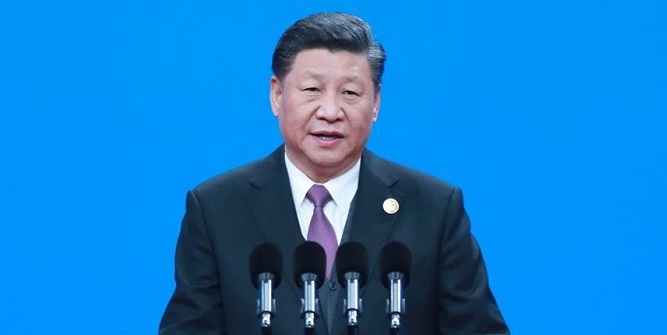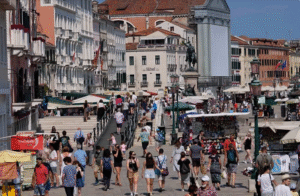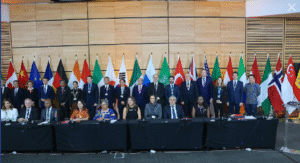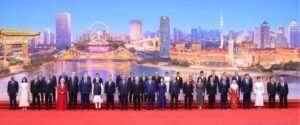Xi Jinping announced a package of proposals at Second Belt and Road Forum for Cooperation

Beijing (Xinhua) — Chinese President Xi Jinping announced a package of proposals to advance high-quality development of the Belt and Road Initiative (BRI) at a key forum widely considered a milestone in promoting win-win cooperation.
The international community should join hands to work out a “meticulous painting” of the BRI to continuously promote its high-quality development toward a bright future, Xi said in a keynote speech at the opening of the Second Belt and Road Forum for International Cooperation (BRF).
About 5,000 participants from more than 150 countries and 90 international organizations attended the event. Among them were nearly 40 heads of state and government.
Russian President Vladimir Putin, the first President of Kazakhstan Nursultan Nazarbayev, Egyptian President Abdel-Fattah al-Sisi, Chilean President Eduardo Pinera, Malaysian Prime Minister Mahathir Mohamad, Pakistani Prime Minister Imran Khan and UN Secretary-General Antonio Guterres addressed the opening ceremony.
The principle of extensive consultation, joint contribution and shared benefits should be upheld, said Xi, stressing open, green and clean approaches, as well as goals of high-standard, livelihood-improving and sustainable development.
“The BRI will not become an exclusive club,” Xi said.
Proposed by Xi in 2013, the BRI has opened up new space for world economy with better-than-expected results. In less than six years, the BRI has been extended from Asia and Europe to Africa, Americas and Oceania. The collective action under the BRI is unprecedented in history.
“We should forge a global connectivity partnership to achieve common development and prosperity,” Xi said. “As long as we work together to help each other, even if thousands of miles apart, we will certainly be able to find a mutually beneficial and win-win road.”
Addressing B&R concerns, Xi announced a series of ambitious and concrete measures, including building infrastructure of high quality, sustainability, risk resilience, reasonable pricing, inclusiveness and accessibility.
China will also negotiate and sign high-standard free trade agreements with more countries and support massive personnel exchanges among B&R countries, according to Xi.
Over the past six years, Xi has frequently promoted the BRI on various international platforms. He also visited the sites of BRI projects during his overseas visits.
So far, more than 150 countries and international organizations have signed BRI cooperation documents with China. From 2013 to 2018, the trade volume between China and other B&R countries surpassed 6 trillion U.S. dollars, and China’s investment in B&R countries exceeds 90 billion dollars.
Thanks to the BRI, eastern Africa has its own expressway, the Maldives has its first inter-island bridge, Belarus can produce sedans and the number of freight trains between China and Europe is on the rise. The once rusted Greek port of Piraeus has become one of the world’s fastest-growing container terminals.
Xi in his keynote speech called for focusing on eradicating poverty, increasing employment and improving people’s livelihoods, so that the BRI would better benefit all people and make a tangible contribution to local economic and social development while ensuring commercial and financial sustainability.
Xi announced a series of major reform and opening-up measures to be taken by China: broadening market access for foreign investment, strengthening international cooperation in intellectual property rights protection, increasing imports of goods and services on a larger scale, more effectively implementing international macroeconomic policy coordination, and attaching greater importance to the implementation of the opening-up policies.
China will set up a number of new free trade pilot zones, strengthen the protection of the legitimate rights and interests of foreign intellectual property owners, prohibit forced technology transfer, further reduce tariffs, avoid beggar-thy-neighbor exchange rate depreciation, establish a binding mechanism for the implementation of international agreements, and treat all enterprises and operators fairly.
He also expressed the hope that all countries in the world can create a favorable investment environment, treat Chinese enterprises, overseas students and scholars on an equal footing, and provide a fair and friendly environment for their normal international exchanges and cooperation.
“A more open China will further integrate itself into the world, and deliver greater progress and prosperity for both China and the world at large,” Xi said.
April 26 , 2019
Image : Chinese President Xi Jinping delivers a keynote speech at the opening ceremony of the Second Belt and Road Forum for International Cooperation in Beijing, capital of China, April 26, 2019. – Xinhua/Ju Peng














